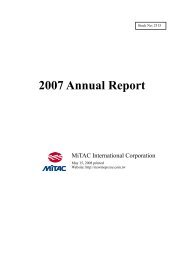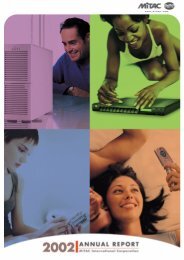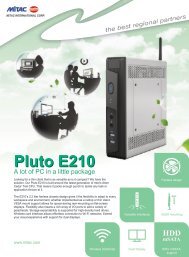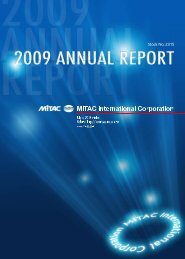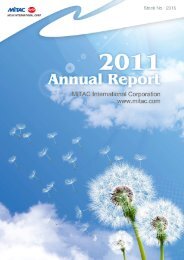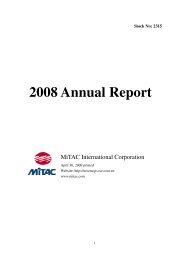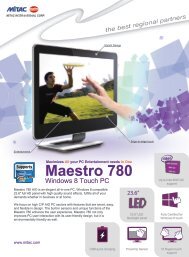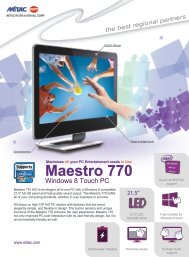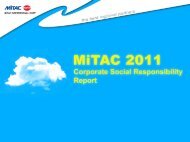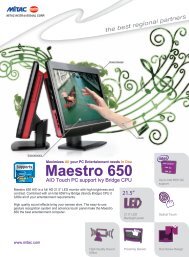Contents - MiTAC
Contents - MiTAC
Contents - MiTAC
Create successful ePaper yourself
Turn your PDF publications into a flip-book with our unique Google optimized e-Paper software.
1.2.2 Server product series<br />
Servers are used primarily for running corporate information systems, and<br />
represent an essential investment that companies make in basic infrastructure. Because<br />
computer systems are a critical tool for sustaining the business of modern corporations,<br />
companies place a great deal of importance on total cost of ownership (TCO) when<br />
considering server purchases. TCO includes the cost of downtime when the system is<br />
not functional, as well as regular maintenance costs. Therefore, server customers<br />
demand system reliability, availability, serviceability, usability, manageability—known<br />
collectively by the acronym RASUM. Servers with strong RASUM require a longer<br />
product development and testing cycle, and such products also carry a higher product<br />
margin and long product lifespan. Major international server vendors are<br />
correspondingly cautious in outsourcing manufacturing and design for their products, as<br />
establishing the necessary close working relationship requires more time. Besides<br />
hardware, software is another key facet of a server solution.<br />
From the perspective of server types, shipments of traditional pedestal servers in<br />
the US market have already begun a gradual decline. Such servers are being replaced by<br />
rack mount models, which have become the mainstream choice. This trend will become<br />
evident in the Europe and Asia markets over the next one or two years. Rack mount<br />
servers are likely to be succeeded by even more compute-intensive blade servers. The<br />
high compute-intensity of rack mount and blade servers entails more stringent system<br />
cooling measures. Vendors will be increasing the share of R&D resources and<br />
investment allocated to these types of servers compared to traditional pedestal servers.<br />
1.2.3 Wireless communications product series<br />
(1) Industry status and development:<br />
a. PDA<br />
According to IDC estimates, in 2005 market share for Windows Mobile<br />
operating systems will catch up to the market share for Palm OS, and go on to<br />
surpass it. Together, the two largest PDA OSes will account for 80% of the market.<br />
Windows Mobile OSes can be expected to appeal to the large number of Windows<br />
users in the PC market, because of such advantages as user familiarity with the<br />
interface, file-level compatibility, full-color multimedia functionality, and fast data<br />
transfer speeds. However, growth in the traditional PDA market slowed after 2002,<br />
entering a transitional period. Although still expanding, the growth stems from<br />
increasing sales of wireless PDA products rather than traditional PDAs. According<br />
to forecasts by Taiwan's Market Intelligence Center, wireless PDAs will account<br />
for close to half of the overall PDA market in the second half of 2004, becoming a<br />
mainstream product.<br />
b. Smart phone<br />
According to IDC statistics, the market for mobile phones in 2003 was<br />
roughly 440 million units, with growth of 10% for the year. In 2004, the size of<br />
the market should increase to over 500 million, with most of the demand<br />
stemming from users replacement of older phones. Numerous products with<br />
extremely appealing new features are being introduced. Such "killer app" features<br />
include color screens, MMS, Java, and polyphonic ring tones are a key driving<br />
force behind market demand for phones. IDC points out that since 2000, smart<br />
phone shipments have been doubling or even tripling yearly. Global shipments of<br />
smart phones reached 13.08 million in 2003 [I think the 13.08 is wrong, since it is<br />
more than the volume predicted for 2007], 3.6 times as many as were shipped in<br />
the previous year. Over the next five years, IDC forecasts that growth in the smart<br />
phone segment will be twice as rapid as for other types of mobile phones. In 2007,<br />
sales volumes are set to reach 8 million. Microsoft's smart phone platform is<br />
strongly supported by Taiwanese contract manufacturers, and products based on<br />
- 25 -



